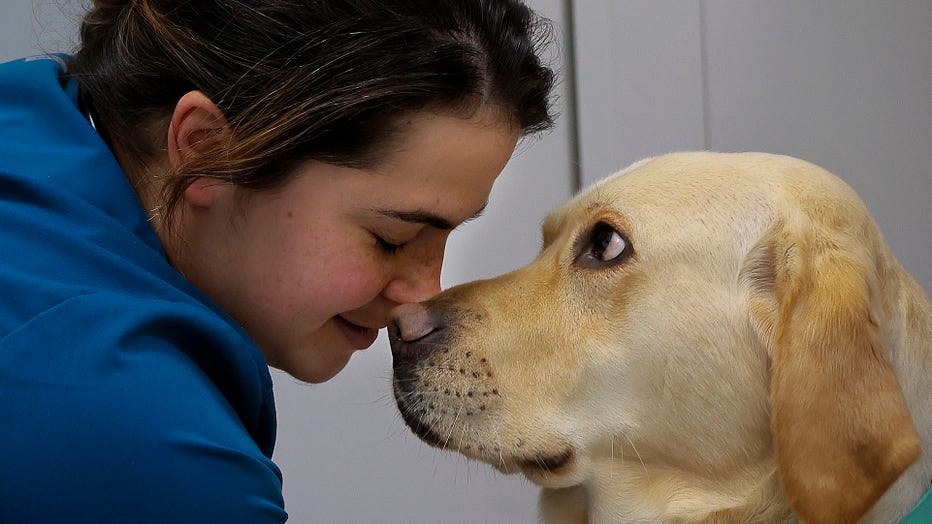Pet insurance: How it works and what to look for in a policy
WATCH: Oklahoma dog accidentally starts house fire after chewing on battery
FILE - The Tulsa Fire Department released a video showing the dangers of keeping lithium-ion batteries like the one seen here within reach of pets or children. All pets safely evacuated the house during the fire. (Credit: Tulsa Fire Department) (August 2024)
With the cost of veterinary care skyrocketing over the past decade, Americans are increasingly turning to pet insurance to help with unexpected – and unaffordable – vet bills.
Americans spent roughly $38 billion on health care and related services for companion animals in 2023, up from about $29 billion in 2019, according to The Atlantic. Although pet insurance has grown in popularity over the past few years, the number of insured pets is actually quite small: Only about 4% of pet owners carry pet insurance, a KPMG report says.
Pet insurance does have its limitations: most policies don’t cover pre-existing conditions, and companies can change policy terms or discontinue coverage altogether. This spring, Nationwide discontinued pet insurance on about 100,000 policies. Thousands of pet owners had to search for other policies, and those plans didn’t cover their pets’ pre-existing conditions, The New York Times reports.
READ MORE: Flying with your dog? New CDC rules take effect: Here's what to know
But even for people who can afford a surprise $5,000 or $10,000 vet bill, pet insurance gives pet owners "peace of mind" and "takes the emotion out of the decision-making process," advisers with Pawlicy, a free platform that compares pet insurance policies, explained.
"[Pet insurance] prevents pet parents from having to draw a line on how much they’d be willing to pay for their beloved family member’s care," Pawlicy advisers said.

FILE - Pet insurance is gaining popularity, but only about 4% of pet owners in America have it. (Photo by Lane Turner/The Boston Globe via Getty Images)
How does pet insurance work?
In most cases, pet insurance works on a reimbursement model — meaning, you pay for the cost of a vet visit upfront, then file a claim afterward to get paid back for expenses covered by your policy, Pawlicy advisers said.
Unlike human health insurance, there are no "in-network" restrictions: Your insurance is accepted at any licensed veterinarian in the U.S.
READ MORE: Pets can smell your stress, study finds
But much like human health insurance, the amount you get reimbursed depends on your policy and whether you’ve met your deductible for the year.
How much does pet insurance cost?
According to Market Watch, pet insurance costs, on average, about $60 per month for dogs and $32 for cats.
READ MORE: 'Potty-mouthed' parrot finds home in New York after hundreds apply to adopt him
That can vary based on what your policy covers and how much your deductible is.
What's the No. 1 reason people seek pet insurance?
According to Pawlicy, the most common pet insurance claims are for urinary tract infections and gastrointestinal issues like diarrhea and vomiting. But generally speaking, pet owners buy insurance policies for "peace of mind."
READ MORE: Dog that spent 473 days in shelter gets chance at ‘new life’
"While pet insurance can be very helpful for covering the cost to diagnose and treat acute illnesses such as these, we’ve found the #1 reason pet parents enroll is for peace of mind over expensive vet bills that can arise from unexpected injuries and chronic conditions, which can cost thousands of dollars out-of-pocket, because pet insurance can make or break the difference between being able to afford the potentially life-saving care their pet needs or not," Pawlicy advisers said.
What if pets have pre-existing conditions?
Pawlicy advisers recommend pet insurance even for pets with a pre-existing condition, because "even though that specific condition may not be covered, they can still get covered for other, unrelated issues that may arise throughout the pet’s lifetime."
Pawlicy said it’s also worth noting that pet insurance policies will cover certain pre-existing conditions – like ear infections or UTIs – after a certain period of time has passed with no recurring symptoms.
What should pet owners look for in pet insurance?
Before you buy pet insurance, Pawlicy recommends researching your pet’s breed and any potential conditions they are genetically predisposed to. You’ll want to make sure those are covered by your pet insurance policy.
READ MORE: This is how much it costs to have a pet in 2024
"Some insurance companies do not cover congenital or hereditary disorders, or they may impose specific coverage restrictions that apply after a certain age, so pet parents should be sure to look for these exclusions in the fine print when choosing a plan to avoid any unpleasant surprises down the road," Pawlicy said.
Which pet owners should consider pet insurance?
The best candidates for pet insurance are puppies and kittens, Pawlicy said, because younger pets tend to visit the vet more frequently for routine care – and because they have weaker immune systems.
READ MORE: 'It felt like a miracle': Family of lost golden retriever Rocky shares impossible reunion story
Veterinarians will recommend pet insurance for most pet owners, but it "may not be the best solution for older pets with multiple pre-existing conditions," Pawlicy said.
What's the biggest misconception about pet insurance?
It’s important to know that pet insurance does not work retroactively – you can’t file claims for care your pet received before enrolling.
There’s also a mandatory waiting period before coverage kicks in, Pawlicy advisers said. That applies to all pet insurance companies.
READ MORE: Adopted dog returned 8 years later before finding new forever family
"It’s important for pet parents to understand that the cheapest plan today isn’t always the cheapest plan in the long run because premiums are subject to increase with age and the average cost of veterinary care," Pawlicy advisers said.


